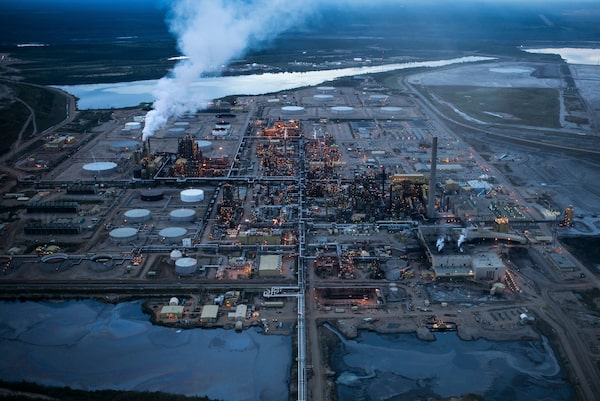
The Syncrude Canada plant at the Athabasca oil sands near Fort McMurray, Alberta, Canada, Aug. 28, 2015.IAN WILLMS/The New York Times
The impact that the oil sands industry has had on the health of a remote community in Northern Alberta will be the focus of a new 10-year study receiving $12-million from the federal government.
Fort Chipewyan leadership says that rates of rare cancers, autoimmune diseases and skin problems have skyrocketed in recent years, leading to excess deaths among people in the Athabasca Chipewyan First Nation, the Mikisew Cree First Nation and the Fort Chipewyan Métis Nation. They believe nearby oil sands operations are the cause, and a community-led study will examine whether there are in fact heightened risks for cancer, health complications and environmental impacts for downstream communities.
Allan Adam, Chief of the Athabasca Chipewyan First Nation, said at a news conference that the health study is welcome news for his community, but added it has been a long time coming.
That point was echoed by Billy-Joe Tuccaro, Chief of the Mikisew Cree First Nation.
Mr. Tuccaro said that even if the federal government hadn’t come on-board, his community had earmarked some of its own funds for a baseline health study that it believes should have been done decades ago, prior to development of the oil sands. “We know there is something going on,” he said. “This health study, it gives me hope that future generations will have a chance.”
Mr. Tuccaro said that the study will provide desperately needed answers about specific health challenges faced by the unique population, and help them improve overall well-being with programs that resonate with the community’s cultural values and needs.
Kendrick Cardinal, President of the Fort Chipewyan Métis Nation, believes the health study will create a ripple effect through the oil sands industry, as an important step in reconciliation that will govern future relationships between the sector and the community.
“Things have changed drastically here, and it’s about time that something like this is happening,” he said, adding that excess mortality rates have caused “a continuous death pool” in Fort Chipewyan. “Equipped with this knowledge, we will be better positioned to advocate for policies, practices and safeguards both for our health and our environment.”
Federal Environment Minister Stephen Guilbeault visited the region this week to speak with members of the community about their concerns around environmental and human health risks associated with living near the Athabasca oil sands.
Those concerns were heightened in February, 2023, when Indigenous communities found out that water laced with toxins from tailings at Imperial Oil Ltd.’s Kearl oil sands mine had been seeping off the site for almost a year. Neither the company nor the Alberta Energy Regulator had informed local communities or the federal government of the issue.
Mr. Guilbeault said he heard firsthand how the Kearl mine spill has affected the community, but also that those concerns are not new – hence the funding for the study, which will come from the departments of Indigenous Services, Environment and Health Canada.
“It’s one thing to understand something intellectually and read about it or even talk to people on Zoom about it,” Mr. Guilbeault said in an interview Wednesday. “It’s another to sit down with them and hear their stories.”
Leadership of the three nations of Fort Chipewyan will work together on the exact design of the study, including the community’s objectives and the study methodology. All three communities have benefit agreements with Imperial Oil Ltd. regarding the nearby Kearl project.
The Alberta government did not respond to an invitation to support the study, Mr. Guilbeault said – something both Mr. Adam and Mr. Cardinal said was indicative of the province’s continued lack of action to protect people from the impacts of the fossil fuel industry.
Ryan Fournier, the press secretary to Alberta Environment Minister Rebecca Schulz, did not explain why the province failed to respond to the federal government. But he said the United Conservative government remains committed to a Memorandum of Understanding with the Athabasca Chipewyan First Nation, signed in 2020, to explore a health study.
The enforcement branch of Environment and Climate Change Canada is in the midst of an investigation into the Kearl oil sands seepage and the February, 2023, incident that brought the seepage to light. In that event, a drainage pond at the site overflowed, spilling an estimated 5.3 million litres of industrial waste water laced with pollutants into the environment.
In a July update on its website, Imperial said that measures to mitigate seeping “are working as intended and preventing further off-site migration of impacted water.” Those measures include interception trenches, sumps and adding liners to on-site ditches.
It said it continues to monitor the effectiveness of the assorted measures and conduct water sampling, and will use the resulting data to enhance mitigations if necessary.
Mr. Cardinal said the ongoing leak is unfortunate, but vowed his community would continue to monitor what’s going on at the site.
“We will continue to fight for our rights and our health and well being of this community,” he said. “We’ll stick to it together – as three nations, and as a community of Fort Chipewyan – to hold industry accountable as best as we can.”